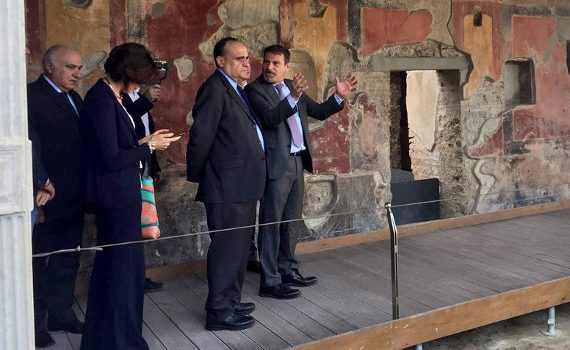From maintenance to excavation two prestigious dwellings brought to light in Regio V
Two prestigious dwellings with precious decorations have been brought to light, and redefine the urban space in Regio V of Pompeii, thanks to maintenance and stabilisation works on the excavation fronts overseen by the Great Pompeii Project.
Re-emerging in their entirety from the lapilli, and with different furnishings, are the House with the Garden, with a beautiful frescoed portico and rooms decorated with lively megalographs, and the House of Jupiter, with First Style paintings and exceptional floor mosaics with unprecedented depictions.
Additionally, inscriptions and further remains of victims add details to the history of the eruption and of the ancient city.
In particular, a charcoal inscription - a tangible trace of everyday life - supports the theory that the date of the eruption was October and not in August. Indeed the writing is dated to the sixteenth day before the Calends of November, corresponding to the 17th October. The inscription appears in a room of the house which was undergoing refurbishment, while the rest of the rooms had already been completed; works must therefore have been ongoing at the time of the eruption. Furthermore, since it was done in fragile and evanescent charcoal, which could not have been able to last long, it is highly probable that it can be dated to the October of AD 79, and more precisely to a week prior to the great catastrophe, which according to this hypothesis occurred on the 24th October.
“This vast maintenance intervention, which is fundamental for the safeguarding of the site - declares Director General Massimo Osanna - has also allowed us to relive the thrill brought by new and interesting discoveries, thanks to the excavations conducted today according to the most advanced methodologies, utilising modern technology and employing a multidisciplinary team of professionals in continuous dialogue. It is also allowing us to observe and document, in great detail, the excavations carried out in the past, thanks to the many traces of Bourbon-era tunnels which we are detecting, and which tell us the story of an era of excavation completely different from our own methodological approach and objectives.”
“The intervention for stabilising the excavation fronts and mitigating the hydrogeological risk of Regiones I, III, IX, IV and V of the archaeological site (GPPM) is one of the last four ongoing sites which form part of the Great Pompeii Project: Published in August 2015 and awarded in May 2016, it has been entirely financed with funds from the 2014-2020 National ‘Culture and Development’ Operational Program. It is - declares Director General of the Project Gen. B. CC Mauro Cipolletta - one of the most significant financial interventions of the Plan of Works, and one on which the monitoring operation is concentrating, as part of the steering committee, in order to ensure compliance with the timetable, which envisages the closure of the site by March 2019. Despite its complex structure, the Directorate General of the project, in synergy with the Archaeological Park of Pompeii, is ensuring full compliance with the Legality Protocol via the control of access to the site and of payments, as well as via the constant monitoring of financial transactions. Compliance with the procedures and obligations imposed by the Protocol are guaranteeing transparency in the execution of works, without hindering the progress of said works which, as both local and national media often report, continue to reveal parts of history which before now had only been hypothesised, shoring up the protection of what had already been brought to light.”


